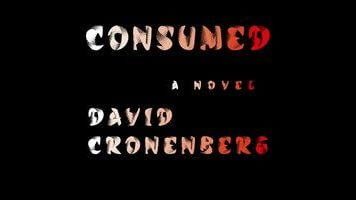David Cronenberg has had two distinct careers as a filmmaker. The first was as the foremost creator of “body horror,” a genre that examined psychological issues through the physical, the flesh becoming a place where neuroses and psychoses manifested themselves. From early work such as Rabid to his adaptation of The Fly, Cronenberg turned the human body into something alien and grotesque, exploring the limits of sexuality and the ravages of disease. His work for the past decade has been qualitatively different, less genre-specific and more interested in the reverberations of violence (both sexual and otherwise). Though recent films like A Dangerous Method have very explicitly explored many of the same themes as his early work, it seemed as if he’d left body horror behind entirely. Instead, he’s changed the medium. His novel, Consumed, seems, in some ways, to fit better with the Cronenberg of the 1970s than the one working now.
Nathan and Naomi are itinerant journalists, reconnecting in airport hotels as they traipse around the world following sordid stories they can sell to magazines. Nominally a couple, they are rarely in the same place at the same time, instead pursuing leads on criminal activity (for Naomi) or unethical medical practices (Nathan). After documenting a black-market doctor in Hungary, Nathan contracts a presumed-eradicated STD, which leads him to Toronto and the house of the disease’s discoverer, Barry Roiphe. Meanwhile, Naomi travels to Paris to dig deeper into the murder of a noted French philosopher who was butchered and eaten by her adoring husband. Soon, Nathan meets Roiphe’s daughter, who holds a strange connection to Naomi’s investigations. As they pursue their leads, the pair finds themselves ever more entangled with their subjects, and with each other.
Fans of Cronenberg’s work will no doubt recognize the director’s various obsessions in Consumed, from the dangers of sexual urges to the way modern technology enhances, and alienates, the body. Unlike other visual artists, who use forays into literature as a chance to explore different aspects of their psyche, Cronenberg seems perfectly at home creating what amounts to one of his films in book form—so much as that it raises the question: Was this originally planned as a film that didn’t pan out?
Another similarity to his movies is the pitch-perfect tension of the first third. Consumed slowly builds suspense as it hops between Naomi’s and Nathan’s narratives, dread seeping into even the most normal interaction. But suspense is worthless without a payoff, and the novel feels aimless instead of precise in its last pages. Aside from an incredibly eerie (and viscerally disgusting) scene in Roiphe’s Toronto home, Consumed never truly capitalizes on the dread it so powerfully creates. Like waiting for a surprise that never comes, the book becomes frustrating as it ends, expectation far exceeding follow-through.
As Consumed closes, it feels more like the start of something than the end of a story. Perhaps that was the intended effect, but it leaves the reader feeling a bit hoodwinked (and not in a good way). Is the plot ancillary to the images, neuroses, and technology Cronenberg explores in Consumed? In the end, one wishes he had gone deeper, uglier, and found a shocking conclusion like the end of The Fly or The Brood. In certain ways, Consumed would be better if it were a bit more Cronenbergian.


 Keep scrolling for more great stories from A.V. Club.
Keep scrolling for more great stories from A.V. Club.